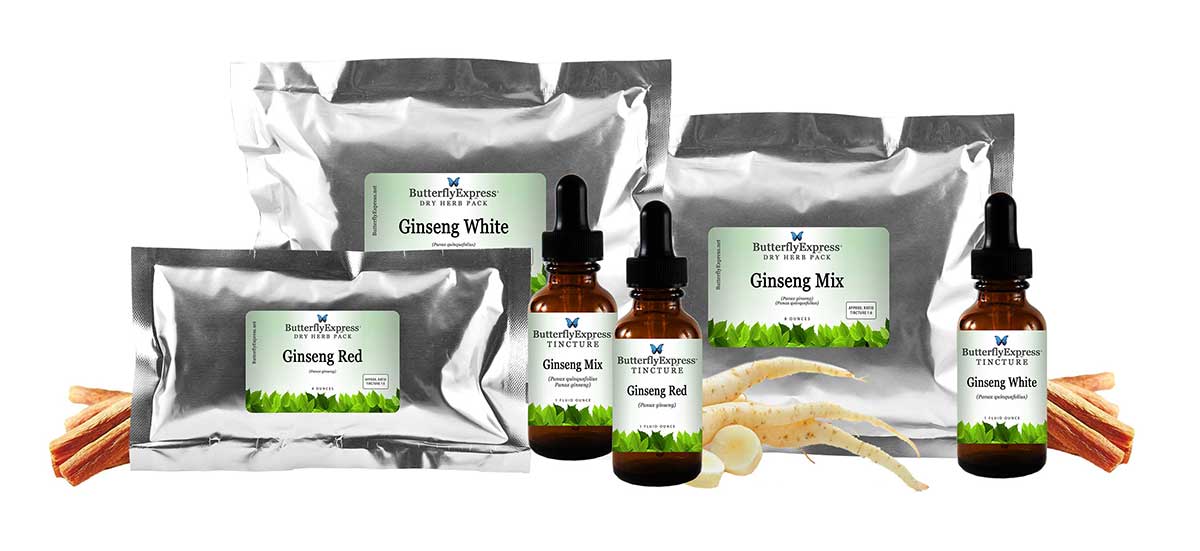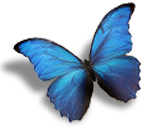|
Ginseng Panax ginseng/Panax quinquefolius PART USED: Root PROPERTIES: Adaptogenic, Antidepressant, Aphrodisiac, Tonic (general and specific to reproductive and endocrine/glandular organs), Nervine SYSTEMS AFFECTED: Nervous, Reproductive, Lungs, Immune, Endocrine/Glandular POSSIBLE USES: increased energy and immune function, blood pressure, stress management, insomnia, and a host of other things! (Please see the section on Alterative and Adaptogenic Herbs in the book for further information.) INGREDIENT IN: AD, CF, HGL, LIC, MH, MULC, MW, PF, PHB, PRT Ginseng is probably the most used and most widely studied herb of all. The information can be confusing, and a little misleading, until you have sufficient knowledge to sort the various species of Ginseng. Panax ginseng, also known as Korean or Chinese Ginseng, is the most widely used and extensively studied. Panax ginseng is considered to be the strongest medicinally. Four closely related species are also used medicinally. These are Panax quinquefolium (American Ginseng), Panax japonicum (Japanese Ginseng), Panax pseudo Ginseng (Himalayan Ginseng), and Panax trifolium (Warf Ginseng or Ground Nut). Of these, quinquefolius (or American Ginseng) seems to be the closest in chemical composition to the more expensive and more difficult to obtain Panax ginseng (Korean or Chinese Ginseng). Another variety, Siberian Ginseng, (which is not a true Ginseng at all) will be discussed at the end of this Ginseng page. Ginseng is processed in two forms: white and red. White is the dried root with the outer skin peeled off and is mostley made from the quinquefolius type of Panax ginseng. Red is whole root which has been steamed. Obviously, steaming or removing the outer layer both alter the final chemical composition of the end product. I do not know why the outer layer is removed or why the Ginseng is steamed. It would seem to me that leaving it alone would be best; I trust there is a reason. There are many types and grades of Ginseng depending on the source, age, and parts used, and on the methods of preparation. Old, wild roots are considered the most potent and the main or tap root is reputed to have the highest medicinal value. For economic reasons, much of the Ginseng on the market is of poor quality and often blended with adulterants. Good quality roots and products are available, however, with a little effort and persistence. In Chinese medical literature and lore, Ginseng is said to restore yang qualities and is often used in male tonics and medicines, and to restore female functions that are the result of too much yin. Translated (roughly) to western thought, this means to balance the male and female hormones. Ginseng is very effective in women whose estrogen levels are too high, putting them at risk for certain cancers, and more likely to suffer ill effects at menopause. Emotionally, following eastern medical philosophy, Ginseng balances the passive/aggressive, nurturing/providing (Fire and Water) aspects of our personalities. The list of uses for any variety of Ginseng is very long in every book on herbal medicine that I have ever seen. I will discuss a few of the most interesting and lesser-known facts about Ginseng on this page. The most noted effects of Ginseng are in the slowing of the onset of both mental and physical fatigue when the body or mind is under great stress. These effects have been demonstrated in both animal studies and double-blind, clinical trials in humans. In studies conducted in the early 1940’s the time to physical fatigue during endurance tests was shown to be lengthened by the ingestion of Ginseng. Mental acuity and the ability to work longer with fewer mistakes was documented among radio operators. The analogy that comes to mind is that stimulant herbs are like stepping on the gas while Ginseng is more like giving the engine a tune-up. Other noted, and well-studied, uses for Ginseng are: in the treatment of diabetes, as a reproductive system tonic and healer, for its immunostimulant properties, in the strengthening of liver function, protecting and strengthening the cardiovascular system, in the protection of cells during radiation, and the rebuilding of damaged cells when the radiation treatment is finished. Ginseng has been shown in clinical trials to have anti-cancer properties. A species of plant, Eleutherococcus senticosus, often referred to as Eleuthero or Siberian Ginseng, is a much used substitute for the Panax varieties discussed above. Not being of the Panax genus at all, Siberian Ginseng has a very different chemical composition; it contains no ginsenosides at all. However, it is a great alterative and adaptogenic herb in its own right. In most respects it is just as effective as the more expensive, and harder to obtain in good quality, Panax varieties. Siberian Ginseng has been shown to produce similar effects on mental and physical stamina. It is as effective in the reduction of sugar levels and lipids in the bloodstream, in toning the adrenal glands, and in regulating blood pressure as Panax ginseng and the other closely related varieties. I find it very interesting that reliable clinical trials have shown conclusively that two such different plants could have such similar effects on the human body. It is a wonderful illustration of the fact that there is more than one way to accomplish cures in the body. This leads me, once more, to the conclusion postulated in the early chapter of this book. One of the reasons, perhaps the biggest reason, herbs work is because they provide the body with badly needed basic nutrition. How much “chemical constituency” and “active ingredients” account for herbal cures, and how much should be attributed to basic nutrition? One notable difference in these two herbs: Panax varieties have repeatedly been shown to be most effective when the body and mind are already showing adverse signs of reaction to stress. Eleuthero, (Siberian Ginseng) on the other hand, when given to healthy human subjects in clinical trials who were then subjected to adverse physical and mental conditions, was shown to increase their ability to withstand the additional stress. After giving this information considerable thought, I began using the two varieties together—acting on the assumption that most of us have some body systems that are already showing signs of debilitation from stress, while other systems are still in good working order for the moment. This has been borne out by muscle testing. How I ask the question, and which body system I am asking about, affects the form of Ginseng that is most appropriate to use. Most of the time I choose to use both. ©Copyright Butterfly Expressions 2020, 2024 |

Purchase Ginseng Products Here |

- Butterfly Expressions LLC
- Empowering Yourself
- OFFICIAL SITE